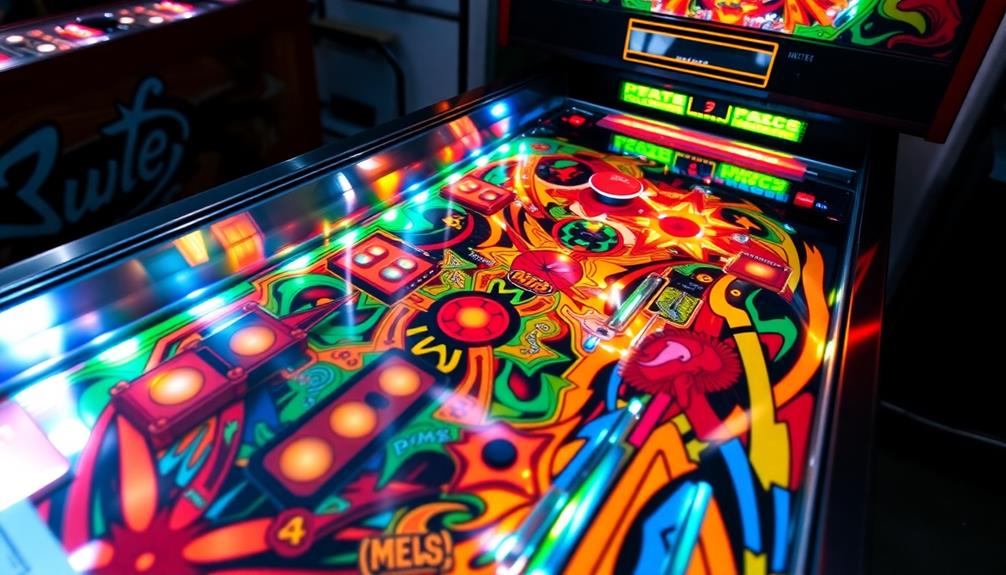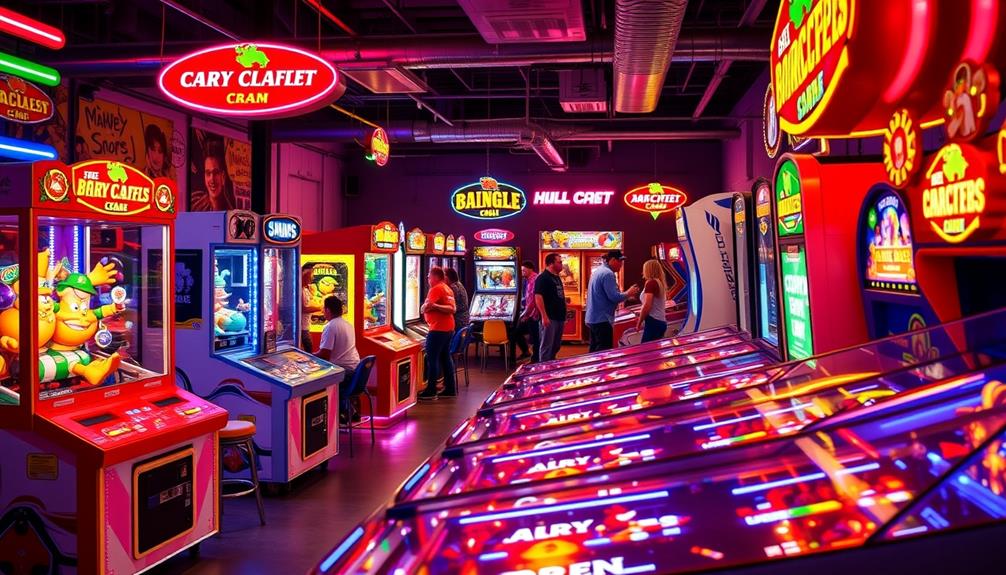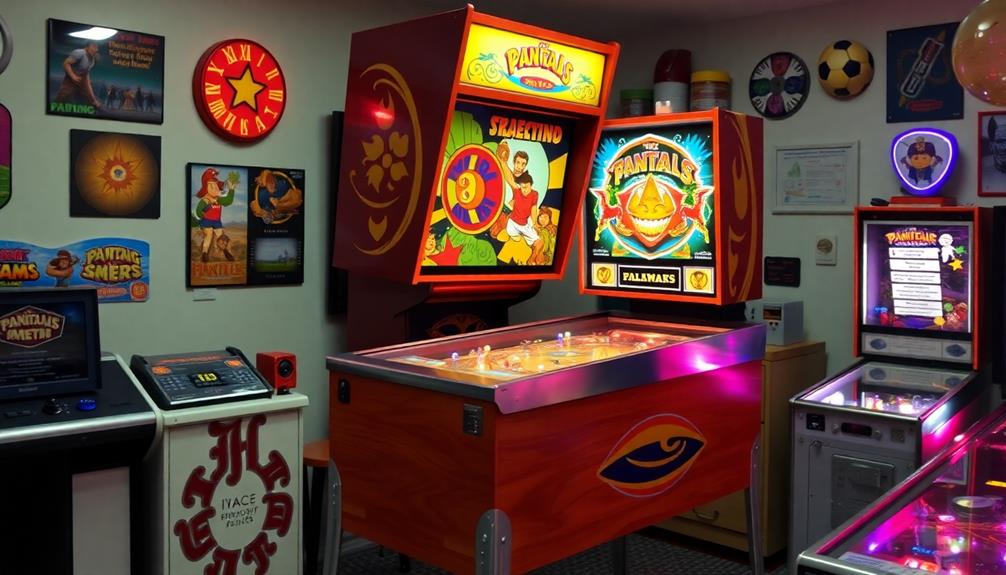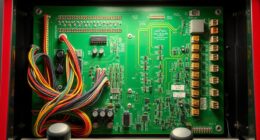A pinball machine consists of various key components that contribute to the enjoyment of playing the game. The playfield, an inclined surface where all the action takes place, allows for the ball to move around. Flippers give you the ability to control the ball’s direction and keep it in play. The cabinet holds the playfield and controls, while the backbox displays your scores and game status. Additionally, other essential elements include the plunger for launching the ball, active bumpers that push the ball away, and drop targets that lower for scoring opportunities. If you want to understand how these parts work together to create an exciting gameplay experience, there is much more to explore! The combination of these elements demonstrates how a pinball machine functions as a dynamic and interactive game of skill and strategy. Lights, sounds, and ramps enhance the experience by providing visual and auditory feedback, making each game unique and engaging. Understanding how a pinball machine functions can deepen your appreciation for the intricate design and engineering behind this timeless arcade classic.
Key Takeaways
- Playfield: The inclined surface where gameplay occurs, featuring targets, ramps, and bumpers for player interaction.
- Flippers: Movable paddles that control the ball's trajectory, essential for keeping the ball in play.
- Cabinet: The main structure that houses the playfield, controls, and provides stability to the machine.
- Backbox: Contains the display and circuitry, showcasing scores and game status to the player.
- Plunger: The spring-loaded rod used to launch the ball into play, controlling its initial speed and direction.
Overview of Pinball Components
When you plunge into the world of pinball machines, you'll quickly discover the essential components that make up these exciting games. At the heart of the action is the playfield, an inclined surface where the excitement unfolds. Here, you'll encounter various targets, ramps, and bumpers designed to interact with the ball, enhancing gameplay and providing dynamic challenges that evolved over the decades, including innovations like electronic scoring introduced in the 1970s technological advancements in the 1970s.
Controlling the ball's trajectory are the flippers, which you use to send the ball flying toward high-scoring areas. They're your primary tool for keeping the ball in play and aiming for those elusive points.
The cabinet houses the playfield and controls, providing the necessary structure and stability for the game.
At the top of the machine, the backbox plays a vital role. It contains the display and circuitry, showcasing your score and game status while housing essential electronic components.
Don't forget the plunger, a spring-loaded rod that launches the ball at the start and during ball returns, allowing you to control its speed and direction. Each of these components works together to create the thrilling experience that pinball is known for.
Key Pinball Terminologies

When you step up to a pinball machine, understanding key terminologies can enhance your game.
From the shooter lane that launches the ball to the drop targets that help you rack up points, each component plays a crucial role.
Additionally, familiarizing yourself with the best rated pinball machines of 2024 can provide insight into advanced features that elevate gameplay.
Let's break down these essential elements and scoring mechanisms to help you play smarter.
Essential Components Overview
Pinball machines consistently captivate players with their vibrant designs and engaging gameplay, thanks to a variety of essential components. The backglass is significant, serving as a decorative cover for the backbox while displaying artwork and important game information like scores and player status.
Many pinball machines incorporate modern technology, making them even more appealing to both casual and serious gamers, as seen in the best arcade machines for home game rooms.
At the bottom of the playfield, you'll find the flippers, which are your controllable paddles. They allow you to direct the ball towards targets, helping you rack up points.
When the ball hits bumpers, those round targets push it away, contributing to your score. Bumpers can be categorized as active or passive, depending on their movement when struck.
Another important feature is the drop targets. These targets lower when hit, often appearing in groups, and they play a key role in scoring and achieving game objectives.
Finally, the plunger is a spring-loaded mechanism that launches the ball into play at the start or when adding a new ball. It gives you control over both the force and direction of the launch, enhancing your gameplay experience.
Each of these components plays a key role in making your pinball adventure exciting and interactive.
Scoring Mechanisms Explained
Understanding scoring mechanisms is essential to maximizing your pinball experience. By familiarizing yourself with how different components work, you can strategize effectively and boost your scores.
Additionally, mastering your diversification strategy in gameplay can help you identify the best scoring opportunities across the playfield.
- Active bumpers propel the ball away upon contact, adding points with each hit.
- Passive bumpers register hits without moving the ball, allowing for a steady accumulation of points.
- Bash toys are interactive elements on the playfield that activate and award extra points when successfully hit.
- Flipper control is vital for maximizing your scoring opportunities, as precise timing can lead to higher point totals.
When you aim for active bumpers, you'll quickly see your score rise.
Meanwhile, passive bumpers provide consistent points, encouraging you to keep the ball in play.
Strategically hitting drop targets can also be beneficial, as they lower when struck and score points for you.
Don't forget about bash toys; hitting them can yield significant rewards.
Mastering flipper control will allow you to navigate the playfield with precision, enabling you to capitalize on every scoring opportunity.
Scoring Mechanisms Explained
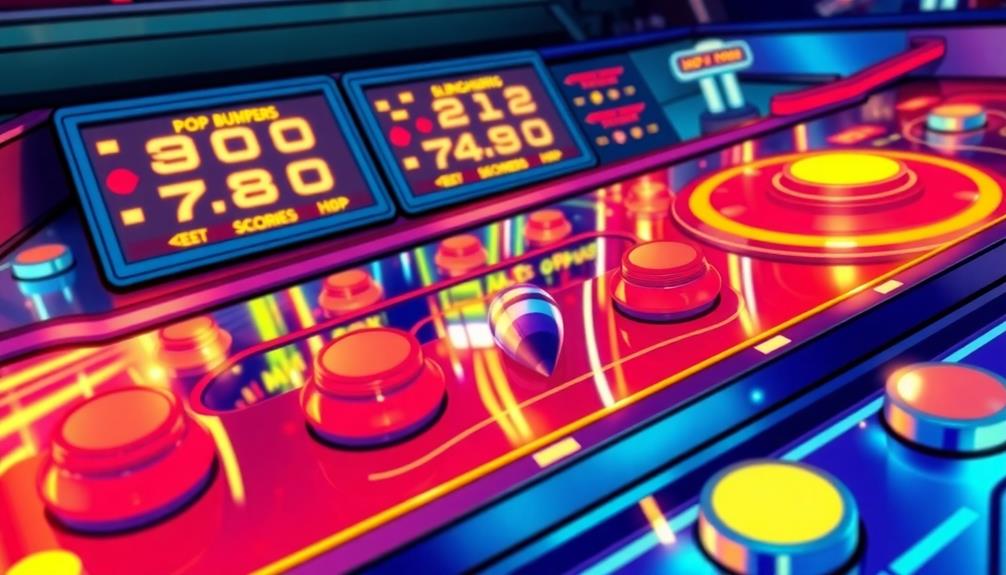
Scoring mechanisms in a pinball machine play an important role in enhancing your gameplay experience and keeping the excitement alive. These mechanisms include active bumpers, passive bumpers, drop targets, and bash toys, each contributing to your overall score in unique ways.
Curiously, much like how astrology claims to influence personality traits, these scoring elements can affect your approach and strategy during the game.
When you hit active bumpers, they propel the ball away, rewarding you with immediate points. Passive bumpers, on the other hand, register hits without moving the ball, allowing you to accumulate points just by making contact.
Bash toys add an interactive twist—when you hit them, you can score extra points, making your gameplay even more engaging.
Drop targets are another important component; when you strike them, they lower and often lead to bonus scoring opportunities based on their arrangement.
Mastering flipper control is essential for maximizing these scoring chances. Your timing and skillful use of flippers can greatly influence the ball's trajectory, helping you navigate through active and passive bumpers while targeting drop targets effectively.
Understanding these scoring mechanisms won't only enhance your gameplay but also help you rack up points more efficiently.
Gameplay Dynamics and Strategies
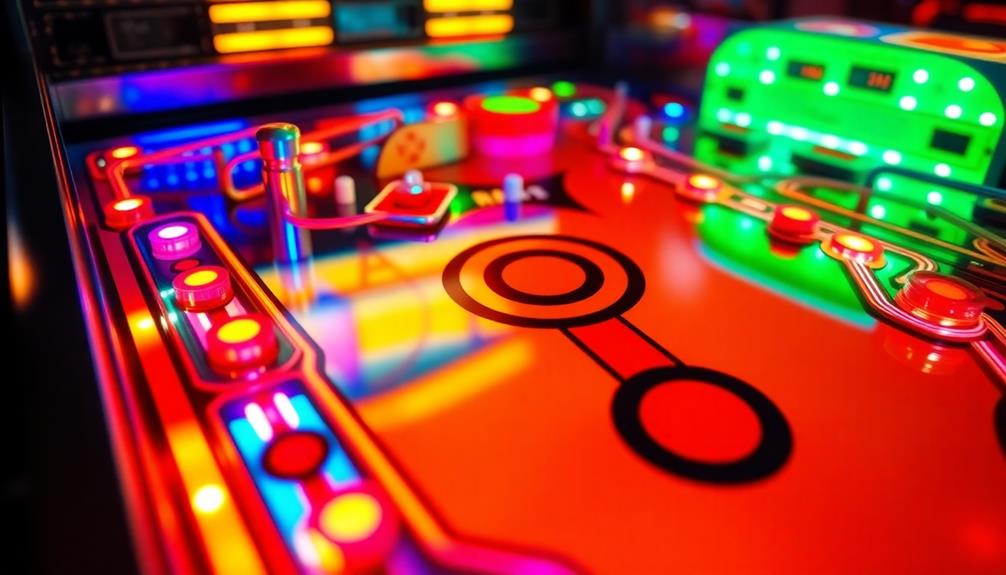
Mastering flipper control techniques is essential for directing the ball to score points effectively.
Understanding the rhythm of the game can also enhance your performance, as seen in the uplifting themes of songs like Blue Skies and Lemonade by Rhythm Failure.
You'll want to implement ball management strategies, like cradling the ball, to set up your next shot.
With these skills, you can enhance your gameplay and increase your chances of achieving high scores.
Flipper Control Techniques
Effective flipper control is essential for achieving high scores in pinball. Mastering techniques like cradling the ball can help you set up precise shots while reducing unwanted momentum.
Incorporating AI-powered virtual reality in e-learning can enhance your practice sessions by simulating various gameplay scenarios. The timing of your flipper buttons plays a vital role in your gameplay; releasing them just after a shot enhances your reaction time and allows for better follow-up actions.
Here are some key flipper control techniques to improve your gameplay:
- Practice dead flips: Minimize flipper movement to maintain better ball control.
- Adjust flipper angles: Control the ball's trajectory by changing how you flip based on speed and angle.
- Utilize both flippers: Passing the ball between flippers can open up more shot options.
- Focus on timing: The right timing can create scoring opportunities and keep the ball back in play.
Ball Management Strategies
During a game of pinball, managing the ball is essential for maintaining control and optimizing your scoring potential. Effective ball management strategies revolve around using the flipper button wisely to keep the ball in play. You can enhance your scoring opportunities by mastering techniques like cradling the ball on a flipper, which allows you to plan your next shot with precision.
Additionally, understanding proper diet and care for your play environment can contribute to a better gaming experience. Timing is critical; activating the flipper at just the right moment can help you execute dead flips, minimizing the ball's momentum for better control. This technique makes it easier to set up your subsequent shots.
Regularly observing the playfield layout is essential, as understanding where the targets and ramps are positioned will help you anticipate the ball's trajectory.
Additionally, using the plunger strategically can set up skill shots that notably boost your points. By integrating these ball management strategies into your gameplay, you'll be able to make informed decisions that lead to higher scores and a more enjoyable experience.
Maintenance and Troubleshooting Tips
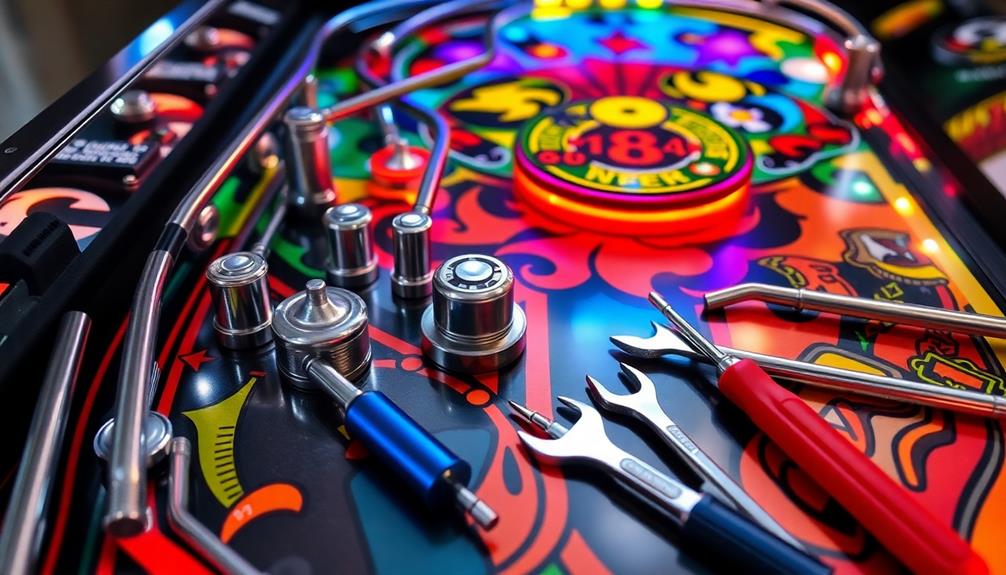
Maintaining a pinball machine is essential for guaranteeing peak performance and an enjoyable gaming experience. Regular upkeep can prevent malfunctions and keep gameplay smooth.
Start by focusing on the playfield and its components, as the importance of maintenance can't be overstated. Dirt and debris can hinder gameplay, so make it a habit to check and clean them regularly.
Here are some maintenance and troubleshooting tips:
- Inspect switches and connectors for wear; non-responsive switches can halt scoring.
- Check the tilt bob to verify it's properly aligned, preventing false tilting that disrupts the game.
- Test the display connections if scores or game info aren't showing; loose connections can cause display issues.
- Keep the coin door functioning smoothly for easy access and proper coin collection.
Historical Evolution of Pinball Machines
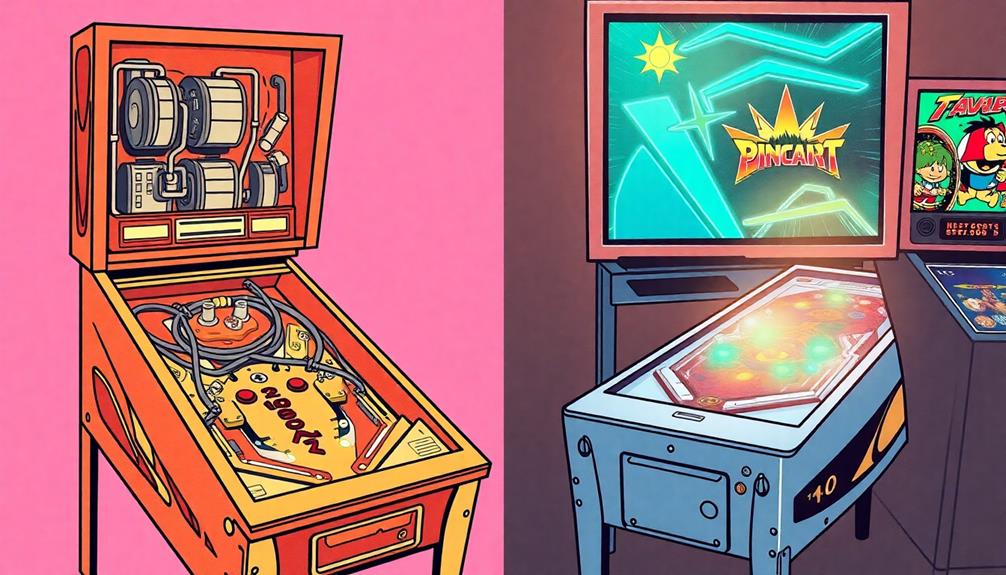
Pinball machines have evolved greatly over the decades, transforming from simple mechanical devices into complex electronic entertainment systems. The journey began with the Electro Mechanical (EM) era, from 1947 to 1978, where mechanical scoring devices dominated and gameplay mechanics were straightforward.
During this period, players often sought relief from the stress of gameplay through means such as essential oils for dizziness relief, which became popular for their calming and invigorating properties.
As technology advanced, the Alphanumeric era (1979-1989) introduced microchips and digital controls, enhancing the complexity of game rules and scoring systems, making it more engaging for pinball players.
Entering the early 1990s, the Dot Matrix Display (DMD) era revolutionized the experience by adding animated visuals that enriched player engagement through storytelling and dynamic scoring. This innovation allowed players to connect with the game on a deeper level.
With the advent of the Liquid Crystal Display (LCD) era around 2013, multi-colored animations and detailed scoring information became the norm, maintaining gameplay similarities to the DMD era while further enhancing interaction.
Looking ahead, future innovations may incorporate features like WIFI connectivity and customizable playfields, promising to continue the historical evolution of pinball machines. These advancements will likely redefine competitive gameplay experiences for both new and seasoned pinball players alike.
Frequently Asked Questions
What Are the Bumpers in a Pinball Machine Called?
When you play, bumpers are those round targets that interact with the ball. They can be active or passive, scoring points differently, and their strategic placement enhances your gameplay experience and scoring potential.
What Makes up a Pinball Machine?
You're not just launching a ball; you're diving into a world! A pinball machine's made up of a cabinet, playfield, backbox, and those delightful bumpers that keep you on your toes. Enjoy the chaos!
What Are the Things That Hit the Pinball Called?
When you play pinball, the components that hit the ball include bumpers, flippers, and slingshots. Each one interacts uniquely, propelling the ball, directing its path, and adding excitement to your gaming experience.
What Are the Mechanics of a Pinball Machine?
When you play a pinball machine, the mechanics involve flippers to control the ball, bumpers that react upon contact, ramps guiding the ball, and a plunger to launch it—all creating an engaging gameplay experience. The history of pinball machines dates back to the 18th century, with the game evolving from a simple tabletop game to the electronic and interactive machines we know today. The first coin-operated version of the game was introduced in the 1930s, and it quickly became a popular form of entertainment. Today, pinball machines can be found in arcades, bars, and even private collections, showcasing their enduring appeal and legacy in the world of gaming.
Conclusion
In exploring the components of a pinball machine, you've unraveled its intricate design and gameplay. Coincidentally, understanding each part not only enhances your appreciation of the game but also sharpens your skills as a player. As you navigate the flashing lights and challenging obstacles, remember that every flipper, bumper, and lane contributes to your experience. So, whether you're a novice or a seasoned pro, recognizing these elements can elevate your game and deepen your enjoyment.
